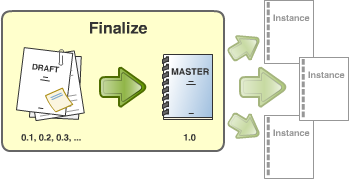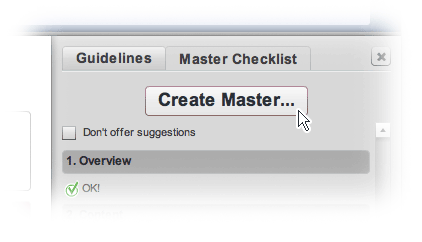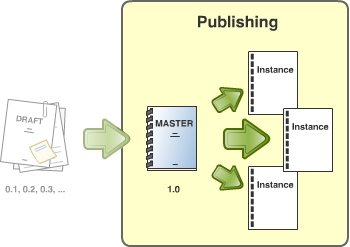The following terminology is important to know when creating Learning Objects in Obojobo.Objects in the Obojobo system come in three flavors:
- Drafts
- Masters
- Instances
The figure below gives an overview of how these types of objects relate to one another

Figure 1: Learning object creation overview
Drafts are converted into Masters, and Instances are created from Masters. Read on for more details on this process.
Drafts
When you start creating a new Learning Object, it starts life as a draft. As the name implies, a draft is an incomplete object. As such, the only people that will see your draft is you and any collaborators you decide to add to your draft object. Students will never see your Draft Object.
In Obojobo, each Draft Object has a corresponding version number. Each new draft begins at version 0.1 Each time you save, your draft’s version number will increase – from 0.1 to 0.2, 0.2 to 0.3 and so on.

Figure 2: The draft saving process
Masters
When you are ready to distribute your object to your students, you must create a Master Object. Before you can do that, you will need to take your draft and finalize it.

Figure 3: Finalizing
Finalizing a draft will convert the draft into a master. In contrast to drafts, which are evolving works in progress, masters are polished, complete, and set in stone.
Since masters are complete products, they are suitable to share with other Obojobo users.
To finalize your draft,
- Login into the Obojobo repository
- Go to the ‘My Objects’ section
- Select the draft object you want to finalize
- Click on ‘Continue Editing’ to launch the object editor
- Click on the ‘Finalize’ tab
- Click on ‘Create Master’ (shown below):

Once you have finalized your object, you can find your newly created Master Object under the ‘My Objects’ section of the Obojobo repository.
Instances
Now that you have created your master, you are ready to distribute your object to your students. To do this, you will Publish Instances of your Master Object. If you can imagine the Master Object to be the original copy, Instances are analogous to photo-copies of the original. In other words, you can create multiple Instances from one Master Object. This concept is demonstrated in the figure below:

Figure 4: The publishing process
This means that you could create one Master Object, publish several Instances, and distribute an Instance per course section or among different courses. To the student, your Instance will look just like your completed Master Object, yet each Instance will contain its own scores (just like each course contains its own student roster).
To publish an Instance,
- Login into the Obojobo repository
- Click on the ‘Masters’ tab in the ‘My Objects’ section
- Select your Master Object under the listing
- Click on the ‘Publish Instance’ button

Continued Development
Over time, you may come up with improvements or changes for your Master Object. Fortunately, while Master Objects are set in stone, you can still edit them. However, once you start editing a Master Object it will begin life as a new draft. If you are editing a 1.0 Master Object, a 1.1 Draft Object will be created if you choose to edit. As you continue editing your new draft, the version number will change from 1.1 to 1.2, 1.2 to 1.3 and so on. Then, when you have completed your draft, you can finalize your object into a 2.0 Master Object.
There is no limit to the number of revisions – your Master Object can evolve from 2.0 to 3.0 to 4.0 and so on.
